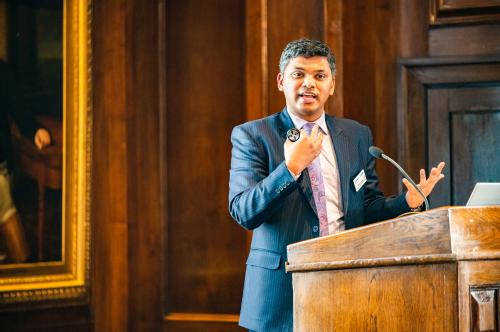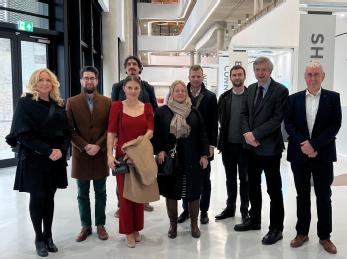WMG News
New report outlines the need for cross domain transport safety standards
- New report outlines the need for a Cross Domain Safety Assurance Framework for Automated Systems to ensure the safe introduction of automated transport systems
- Adoption of this framework would enable faster and safer national roll-out of the technologies in the UK, projected to be worth £700 billion globally by 2030
- The findings recommend the need for an industry-government and academia body responsible for safety assurance as well as scenarios available for stakeholders and regulators
- The report calls for a codified set of rules to define safe and acceptable behaviour for automated transport systems as well as a scalable safety assurance framework
A new report launched by WMG, University of Warwick’s Dr Siddartha Khastgir identifies the need for a Cross Domain Safety Assurance Framework to ensure the safe introduction of automated transport systems across land, air and marine.
The report outlines three key building blocks of research, standards, and regulations required for the safety framework: test scenarios, test environment, and safety evidence and safety argument.
The transport sector is worth over £100 billion to the UK economy, but with over 2,000 deaths and over 120,000 injuries every year. Safety remains a key priority.
Connected and autonomous transport, set to be worth over £700 billion by 2030, not only has the potential to make travel safer but also faster and more efficient, contributing to both national health and carbon emissions goals.
To support the development and adoption of a cross-domain safety assurance framework, the findings of the report recommend the need for a government - industry and academia body responsible for safety assurance of autonomous transport systems. This will enable fertilisation of ideas across land, air and marine as each work to solve the same set of research and engineering questions.
The report identifies the need for a centralised scenario library to draw on to support testing to standards. It also highlights the importance of developing a Virtual Test Environment (VTE) for use by regulators as well as a qualification process for VTE and enhancing the UK’s National Digital Twin Programme to realise this. The findings also call for a codified set of rules to define safe and acceptable behaviour for automated transport systems on land, air and sea as well as a scalable safety assurance framework.
Dr Siddartha Khastgir commented: “If we’re serious about the safe introduction of automated transport systems, we need to focus on setting high standards for safety assurance and ensuring we’re not competing on safety. Collaboration will be key to our success.”
“Taking a cross-domain approach to safety assurance offers various opportunities and benefits to the ecosystem. Firstly, it enables us to learn from the strengths of individual (land, air, and sea) domains. Then, on a more practical note, the associated tools, and procedures in implementing the safety assurance framework such as databases and virtual test environments can be used across all domains, making it cost effective. Finally, and importantly, it helps to avoid triplication by translating learnings and helping foster relationships across these traditionally siloed and independent domains – altogether making research and deployment of autonomous transport systems more efficient.”

Andrew McKeran, Business Director, Maritime Performance Services at Lloyd’s Register Group said: “There is a significant opportunity for the UK to be a global leader in maritime autonomy, developing a long term, hi-tech ecosystem.
“From a maritime perspective, we need a robust, reliable and usable global assurance framework for the safe operation of autonomous ships. The result will be confidence in the data, confidence in the decision-making, and confidence in the systems that are needed to exploit the safety and economic benefits that autonomy can bring.”
"We see great opportunity to collaborate with the other sectors, primarily aviation and automotive to learn lessons, mature thinking, and most importantly develop virtual test environment capabilities for maritime technology applications.”
Michael Gadd, Head of Airworthiness, Blue Bear commented: “Aviation has a global perspective and within this sector the UK has considerable innovative capabilities and technologies. These advancements are supported by pioneering safety and regulatory frameworks which continually install the trust and confidence that enables the economic benefits the sector delivers, from leading-edge research and development to the wide range of aircraft operations and everything in between.
“The development of a cross-sector safety assurance framework will empower the wider sharing of experience and best practices and help deliver the tools and techniques that are necessary to build confidence and trust in high authority automation and autonomous systems in a common way irrespective of the end use case.”
“This collaborative approach between sectors will develop key skills and knowledge whilst accelerating the assurance process to deliver demonstrably safe products to market, maximising opportunities for economic growth and also developing experience-based leadership in a globally competitive area.”
To read the full report, please visit: https://warwick.ac.uk/fac/sci/wmg/research/cav/vandv/ukriflf/cross_domain_safety_assurance_framework_for_automated_systems.pdf
ENDS
NOTES TO EDITORS
About WMG, University of Warwick
WMG is a world leading research and education group, transforming organisations and driving innovation through a unique combination of collaborative research and development, and pioneering education programmes.
As an international role model for successful partnerships between academia and the private and public sectors, WMG develops advancements nationally and globally, in applied science, technology and engineering, to deliver real impact to economic growth, society and the environment.
WMG’s education programmes focus on lifelong learning of the brightest talent, from the WMG Academies for Young Engineers, degree apprenticeships, undergraduate and postgraduate, through to professional programmes.
An academic department of the University of Warwick, and a centre for the HVM Catapult, WMG was founded by the late Professor Lord Kumar Bhattacharyya in 1980 to help reinvigorate UK manufacturing and improve competitiveness through innovation and skills development.
WMG has been successfully leading and participating in national and international collaborations such as OmniCAV, Midlands Future Mobility, Safety PoolTM Scenario Database as well as working on CCAV and Innovate UK funded Collaborative R&D projects. WMG’s research is helping to influence international standards and regulations with active participation at ISO, ASAM, SAE and UNECE forums.
PHOTO CAPTIONS (hi res available on request):
1. Dr Siddartha KhastgirLink opens in a new windowLink opens in a new window presents his report
2.L to R: Prof Paul Jennings, Research Director at WMG; Sarah Gates, Wayve; Andre Burgess, National Physical Laboratory; Andrew Macmillan, Vertical Aerospace; Michael Gadd, Blue Bear; Jane Fenn, BAE Systems; Ali Chegini, RSSB; Dr Siddartha Khastgir, WMG.
CONTACT
Sheila Kiggins
Media Relations Manager
University of Warwick
07876 218166
Celebrating British Science Week 2022
The WMG team had a busy, fun-packed British Science Week, taking part in six special STEM events reaching out to more than 2015 young scientists and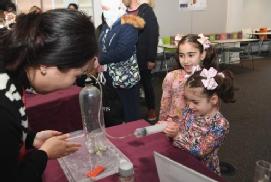 engineers.
engineers.
British Science Week is a ten-day celebration of science, technology, engineering and maths; and is a chance to look into the future and celebrate the impact scientific ideas can make on society. In support, the Team took part in the University of Warwick’s ‘Slice of Science;’ attended the Royal Institution’s Powering our Sustainable Future event, where Rohin Titmarsh and Phil Jemmett shared their expertise on battery tech and robotics; and conducted experiments at a library science fair in Staffordshire.
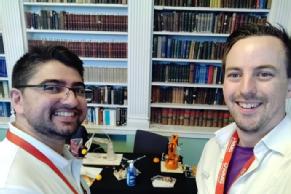 Dr Phil Jemmett, Outreach Project Officer at WMG, said: “Presenters at the events noticed students building in confidence as they engaged with our staff, and we have received some really positive feedback from both organisers and parents.”
Dr Phil Jemmett, Outreach Project Officer at WMG, said: “Presenters at the events noticed students building in confidence as they engaged with our staff, and we have received some really positive feedback from both organisers and parents.”
The team at Perton Library said the ‘experiments were great – excellent explanations for the children.’
A parent at the Ri event said it was an ‘excellent event. Having the booths from universities/companies after the event was a great bonus for my son. He had the chance to discuss not only about batteries but about different courses to study as he is still undecided as to which course to choose.’
Another parent added: ‘It gave my 17-year-old a frame of reference to where a career in STEM could lead.’
Phil explained: “For the UK to remain at the forefront of innovation, a strong and diverse workforce will be needed. We believe that events such as these can give youngsters the information and the inspiration, they need to pursue a STEM career.”
The Outreach team would like to say a huge thank you to Bethany Haynes; Rebecca Swan-McAdam; Mucahit Ozden; Veronika Majherova; Yiduo Wang;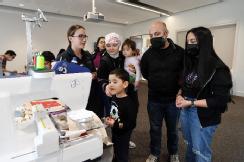 Zeina Rihawi; Jianhua Yang; Rohin Titmarsh; Tom Goodman; Rachael Kirwan; Eugene Prout; Nilavan Thipaharan; Bianca Agapito; and Claire Davis, for their help and support at the events.
Zeina Rihawi; Jianhua Yang; Rohin Titmarsh; Tom Goodman; Rachael Kirwan; Eugene Prout; Nilavan Thipaharan; Bianca Agapito; and Claire Davis, for their help and support at the events.
Find out more about WMG’s Outreach programme, including the Lord Bhattacharyya Engineering Education Programme and the Resonate Festival, taking place in April, here: Public engagement and Outreach (warwick.ac.uk)
Members of the Slovakia government visit WMG
Delegates from the Slovakian government visited WMG, University of Warwick for an introduction into the department’s ground-breaking battery R&D and a discussion on the importance of industry and academia collaboration.
A total of eight delegates led by State Secretary, Ministry of Economy, Ján Oravec enjoyed a tour of the Energy Innovation Centre (EIC) by Chief Engineer, Mark Amor-Segan who demonstrated EIC’s facilities to research, develop and test the latest technologies at the forefront of energy storage.
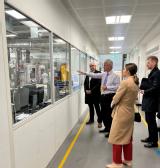
Professor Paul Jennings, Director of Research at WMG, University of Warwick who hosted the visit said: “It was great to be able to meet the delegation and showcase the power of academia and industry working together, demonstrating how we are helping to drive the sector forward through impactful research and new education and skills offerings.”
Find out more about WMG’s energy research here: https://warwick.ac.uk/fac/sci/wmg/research/energy/
WMG launches EV battery recycling facility
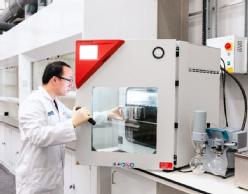 WMG, at the University of Warwick, has revealed its new EV battery recycling scale-up facility, the first of its kind in the UK.
WMG, at the University of Warwick, has revealed its new EV battery recycling scale-up facility, the first of its kind in the UK.
The adoption of electric vehicles has created a huge demand for battery metals such as lithium, nickel and cobalt; and this will accelerate each year as electric vehicles replace conventional vehicles. UK-based OEMs pay hundreds to recycle end-of-life lithium-ion batteries that are then exported abroad for material recovery, with the material later repurchased. Recycling of batteries in the UK will provide a stable and sustainable supply of indigenously sourced metals that will be vital for the UK’s automotive needs.
Anwar Sattar, Lead Engineer at WMG, explains: ‘‘The UK has some of the best research organisations in the world, and this facility will now enable us,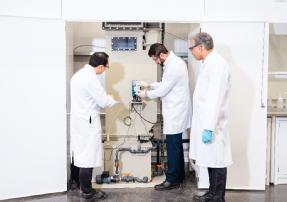 like our international peers, to take our innovations to the EV market direct.
like our international peers, to take our innovations to the EV market direct.
“We can now carry out kilogramme scale research which will allow us to attain data that is much more valuable to the UK industry, allowing them to make informed decisions about issues such as material handling and separation, scalability, product quality and waste production.’’
Professor David Greenwood, CEO of the WMG Centre HVM Catapult and Director of Industrial Engagement adds: “Batteries are a key enabler to the use of zero carbon energy, and they are a great industrial opportunity for the UK. Making them uses significant quantities of valuable materials, so it is essential that they are safely collected and recycled at the end of their useful life – providing the material feedstock for future generations of batteries. Today’s processes recover as little as 50% of the mass of the battery, and require large quantities of energy and chemicals as inputs. This new facility at WMG will allow us to research new recovery techniques which are more effective, cleaner and cheaper to operate.”
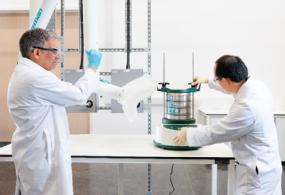 The new recycling facility, funded by the High Value Manufacturing Catapult, is situated within the Advanced Materials Manufacturing Centre. It is equipped with state-of-the-art equipment such as a wet alkaline scrubber which will enable researchers to safely carry out experiments that are not possible elsewhere. It is designed to accommodate pilot scale recycling machinery including dryers, furnaces, separators, and various reactors for the chemical recovery of metals. The facility will also host a scaled-up version of WMG’s novel lithium recovery process which will be able to recover over 90% of the lithium in a battery at very high purities.
The new recycling facility, funded by the High Value Manufacturing Catapult, is situated within the Advanced Materials Manufacturing Centre. It is equipped with state-of-the-art equipment such as a wet alkaline scrubber which will enable researchers to safely carry out experiments that are not possible elsewhere. It is designed to accommodate pilot scale recycling machinery including dryers, furnaces, separators, and various reactors for the chemical recovery of metals. The facility will also host a scaled-up version of WMG’s novel lithium recovery process which will be able to recover over 90% of the lithium in a battery at very high purities.
Various projects are already underway at the facility including an £8.9m project ‘Recycling of EV Cells from Obsolete Vehicles at Scale’ (RECOVAS). Supported by the Advanced Propulsion Centre, the project will create a circular supply chain for electric vehicle batteries in the UK.
Find out more about WMG’s battery research here: Energy (warwick.ac.uk)
WMG researchers head to the Palace of Westminster
Researchers from WMG and the School of Engineering, at the University of Warwick, attended two bespoke Parliamentary Seminars at the Palace of Westminster in March.
Westminster in March.
A total of 18 researchers enjoyed a guided tour of the Central Lobby before observing live sessions with MPs and Lords in both the House of Commons and the House of Lords.
The visits were hosted by the Industry and Parliament Trust (IPT) and facilitated by Huw Edwards, Parliamentary and Government Training Consultant and former MP.
Huw provided an overview of the work of UK Parliament, the legislative process, and the scope for research in the Government.
Sarah Wilson from WMG Research Office, who organised the visits, explained: “The aim of these visits was to empower our researchers to share their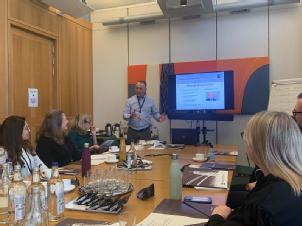 knowledge and expertise with key policymakers, influence and inform relevant policy, and support parliamentary scrutiny processes.
knowledge and expertise with key policymakers, influence and inform relevant policy, and support parliamentary scrutiny processes.
“It was an invaluable experience - they heard about various engagement points, and the means to liaise with key government departments and Parliamentary Select Committees.”
Find out more about WMG’s breath of research here: Research (warwick.ac.uk)
WMG’s Professor Margaret Low awarded an MBE
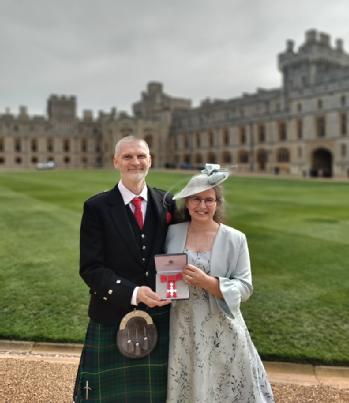 WMG’s Professor Margaret Low was presented with an MBE, for her services to public engagement and widening participation, on Tuesday 15th March by HRH The Princess Royal at a special ceremony at Windsor Castle.
WMG’s Professor Margaret Low was presented with an MBE, for her services to public engagement and widening participation, on Tuesday 15th March by HRH The Princess Royal at a special ceremony at Windsor Castle.
Professor Robin Clark, Dean of WMG, and Director of Education explains: “Margaret joined WMG back in 1988, and for many years she has made it her mission to inspire young people from all backgrounds in STEM subjects and into higher education. We are all so proud of her many achievements.”
Margot James, Executive Chair at WMG adds: “Margaret’s MBE is a true testament to her hard work and dedication in connecting the local community with academia and, promoting STEM in an engaging way. I send her my warmest congratulations.”
Professor Margaret Low said: “It’s lovely, if a little overwhelming and totally unexpected, to be recognised in this way. Everything I’ve achieved has been in collaboration with fantastic colleagues and friends at WMG and across the University. None of this would have been possible without their hard work and dedication.
“I’ve also had the good fortune to work with some brilliant students through Warwick Volunteers who’ve been instrumental in bringing outreach activities into schools.”
Working with Warwick Volunteers, Margaret collaborates with University of Warwick students to run Scratch workshops in local primary and secondary schools reaching more than 250 children each year through the Technology Volunteers project. During the Covid-19 pandemic, Margaret and her team also developed invaluable resources to help support home-schooling.
In 2016 Margaret was awarded an HEA National Teaching Fellowship. The Fellowships recognise and celebrate the absolute highest standards of learning and teaching across higher education.
More than a decade ago she pioneered the use of Scratch in the UK, a user-friendly programming tool, for outreach work in schools.
Read more about the WMG Public Engagement and Outreach Programme here: Public engagement and Outreach (warwick.ac.uk)
Partnership between WMG and The Blair Project to deliver electrification skills training in the north

WMG has partnered with The Blair Project, a social enterprise based in Manchester, to deliver the Emerging Skills Project in the north, a programme funded by the Department for Education (DfE).
The Emerging Skills Project will create a highly skilled workforce that will enable industries including automotive, energy and food and drink, to take advantage of electrification and hydrogen-power to deliver Net Zero.
The course provided by The Blair Project will specifically address technologies related to electric vehicles. This will include the assembly and maintenance of battery modules and packs, recycling and second life, the manufacturing and installation of motors, drives and power electronics and the designing and testing of vehicle and software systems.
Developed in conjunction with businesses who were invited to a series of workshops with DfE, the course will directly respond to the demand for wider adoption and deployment of transport electrification technologies.
The course will be held at the new Manchester Innovation Activities Hub (MIAH) – launching in Spring 2022. Dedicated to the rapid upskilling, reskilling and retraining of more than 5,000 local residents over the next five years, MIAH is set to become a centre of excellence in Greater Manchester and a hub for electrification skills training in the north.
Ben Silverstone, Associate Professor and Head of WMG Skills Centre, said:
“As important as it is to train up the younger workforce in green tech, there is a significant workforce primed for reskilling now. It’s the combination of both that will ensure we are well-equipped to meet the UK’s ambitious Net Zero targets.
“We are pleased to partner with an organisation like The Blair Project to deliver the Emerging Skills Project, meeting the UK-wide demand for electrification skills and giving people in the region the opportunity to upskill or reskill in this area.”
Nile Henry, Founder and CEO of The Blair Project, said:
“The UK is facing a huge skills gap in green tech, particularly electrification, and this is only set to increase as we power towards Net Zero and the demand for a highly skilled workforce grows. Partnering with WMG to become a delivery partner for the Emerging Skills Project is a huge milestone for The Blair Project, and it’s brilliant to see this focus from Government on upskilling adults in green tech.”
WMG expert contributes to Micromobility Whitepaper
WMG’s Head of Human Factors for Future Mobility, Dr Roger Woodman, has shared his expertise in a whitepaper entitled ‘Navigating new technologies and the safety and business risks.’
The whitepaper, produced by DriveTech UK, from The AA, the world leader in fleet risk and driver safety management; including driver training, aims to inform businesses about the challenges and risks of micromobility, as well as their corporate obligations.
It also anticipates a wider and likely legalised use of private e-scooters, in the near future, and recommends a serious need to focus on training to keep all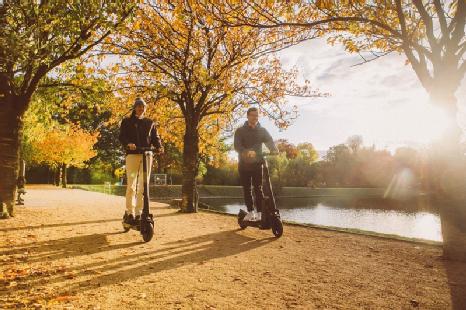 users safe.
users safe.
Dr Roger Woodman explains: “It’s highly likely that rental and private e-scooters will be legalised in the next year or so. Undoubtedly there will be restrictions on these vehicles for both speed and weight. Rental e-scooters will be relatively easy to maintain control of, and from what I have witnessed, the trials have been broadly successful.
“However, the legalisation of private e-scooters is where issues will arise and will quickly become a big social and safety problem if certain things aren’t considered. The most important of which is people will modify e-scooters to make them go faster.
“Consequently, we need to introduce rules similar to car and motorbike ownership, which makes people more aware that they are responsible for what they do with the vehicle and importantly there is a link between them, the vehicle and law enforcement. Psychologically this is very important and is one of the reasons the e-scooter rental trial has made it a requirement that riders must have at least a provisional driving license.
“I believe we need several legal rules imposed with the legalisation of private e-scooters. Firstly, all private e-scooters (including rental), should require a registration plate. Secondly, e-scooters should be taxed and insured in the same way as motorbikes. This requirement greatly reduces the number of people who can own and operate an e-scooter, and I expect this will be dropped for both rental and privately owned e-scooters. However, there will be greater emphasis put on training, which will include safe riding and the Highway Code.”
Read the report in full here: DriveTech-E-Scooter-White-Paper.pdf
WMG is in the process of creating a Micromobility Roadmap, in consultation with users and industry, which will be made public later this year. Read more about WMG’s Intelligent Vehicles research here: Intelligent vehicles (warwick.ac.uk)
WMG supports innovation in polymer science for a sustainable future
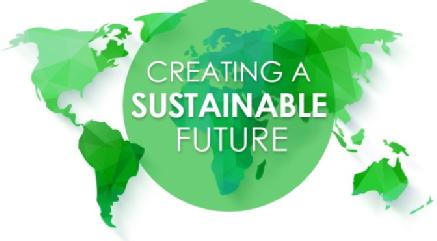 WMG researchers based in the International Institute for Nanocomposites Manufacturing (IINM) have been developing a range of polymer-based solutions for application across several critical sectors, including renewable energy, sustainable transport, and replacement of single use plastics, helping to contribute to a sustainable future.
WMG researchers based in the International Institute for Nanocomposites Manufacturing (IINM) have been developing a range of polymer-based solutions for application across several critical sectors, including renewable energy, sustainable transport, and replacement of single use plastics, helping to contribute to a sustainable future.
Here’s a summary of the key projects.
Renewable Energy: Graphene Enabled All Polymer Solar Thermal Cell
Professor Tony McNally working with Dr Sandeep Kumar in partnership with Senergy Innovations Ltd, has submitted patent applications to the UK Intellectual Property Office that describe 2D material filled polymers for use in Solar Thermal Cells. Critically, the materials developed have very high ‘in-plane’ and ‘through-plane’ thermal conductivity and can be processed using conventional polymer processing methods.
The project was supported by BEIS £11M Energy Entrepreneurs Fund. This scheme is for the development and demonstration of state-of-the art technologies, products, and processes in the areas of energy efficiency, power generation, and heat and electricity storage.
Christine Boyle, CEO of Senergy Innovations Ltd, commented: " Working with the IINM and WMG has allowed Senergy to push the boundaries with innovative technology that has the potential to bring a lot of societal good in sustainability and job creation, also enabling future innovation within the business. Dramatic cost reductions of more than 40% are possible when solar thermal systems are re-engineered with high performance polymers. In 2022 we will work alongside our early customers to showcase how the Senergy solar panels can now reduce the cost of delivering solar hot water and heating to a price point that will finally compete with gas and oil."
Professor McNally said: “We are really excited by this exploitation of our research which has far reaching applications in numerous other sectors, including thermal management in electronic devices and electric vehicles.”
The design for manufacture aspects of the development of the solar thermal cell were supported by the High-Volume Manufacturing (HVM) Catapult and the WMG SME Team.
Sustainable Transport: New Chemistry Enables Conventional Sulphur-vulcanised Tyre Tread Rubbers to Self-heal
Dr Chaoying Wan working with Dr Alan Wemyss in collaboration with Bridgestone EMIA have recently filed a patent application which describes the design and inclusion of dynamic bonds in vulcanised rubbers. This allows the conventional covalent-crosslinked rubber networks to be adaptive to external mechanical damage, self-healable and be reprocessed. The dynamic crosslinking networks also promise excellent mechanical properties and fatigue-resistance that are comparable to conventional rubber vulcanizates.
Dr Raffaele di Ronza, R&D Open Innovation Expert at Bridgestone EMIA commented: “At Bridgestone we have a high focus on sustainability and material technologies to extend tyre life, a key element of our strategy in this field. Through this collaboration with WMG we could explore new solutions that support the realisation of our long-terms targets.”
Dr Chaoying Wan said: “We are delighted with the progress that has been made in improving the sustainability of vulcanised rubber products during our collaboration with Bridgestone. We are now able to further our understanding of self-healing vulcanised rubbers thanks also to the support from WMG and the High Value Manufacturing Catapult which will take us further towards in-depth understanding of elastomer science and new technology development for sustainable elastomer manufacturing.”
Replacement of single-use plastics: Sustainable Bioplastics for Food Packaging Applications
Dr Chaoying Wan and Professor McNally in partnership with Pujing Chemical Industry Co., Ltd., have developed fully biodegradable plastics with the gas barrier and mechanical properties required for food packaging applications. Poly(glycolic acid) or PGA has great potential as a substitute for current single-use plastics used in food packaging applications but with a lower carbon footprint. By blending and promoting interfacial interactions between PGA and other bioplastics, such as PBAT, the team have developed sustainable plastics for food packaging.
In collaboration with Sherkin Technologies UK Ltd., the team have been able to enhance the barrier properties of PGA/PBAT further by crosslinking the outer surface of the films using low energy electron beam treatment.
Dr Bowen Tan, Research Manager (UK), Pujing Chemical Industry Co., Ltd. Stated: “We collaborated with WMG on a research project on the blending of biodegradable plastics for flexible packaging applications. They have provided specialist and a wealth of expertise on plastic processing and modification. WMG is equipped with a wide range of polymer processing and testing equipment which enable our research to be carried out from small to manufacturing scales. The outcome of the project was beyond our expectation.”
Mr Donal O’Sullivan, Managing Director, Sherkin Technologies UK Ltd. Commented: “Plastic packaging plays an important role in the reduction of food waste. Biodegradable food packaging usage has great potential to meet local and global targets for the use of sustainable packaging. The recent work undertaken by the IINM, and their industrial partners is an important step in demonstrating the potential for Low Energy Electron Beam as a platform technology which can be deployed to improve and optimise barrier properties in a new generation of biodegradable films.”
Read more about WMG’s Nanocomposites research here: Nanocomposites (warwick.ac.uk)
Using digital flash glucose monitoring for people with diabetes & COVID-19 frees up NHS resources
- Patients with diabetes hospitalised with COVID-19 at University Hospitals Coventry and Warwickshire (UHCW) NHS Trust used flash glucose monitors as inpatients rather than traditional methods
- This approach was evaluated by researchers from WMG at the University of Warwick and University Hospitals Coventry and Warwick NHS Trust
- Patients who used the non-invasive skin monitors were adequately cared for and freed up resources making the care and monitoring of the high-risk
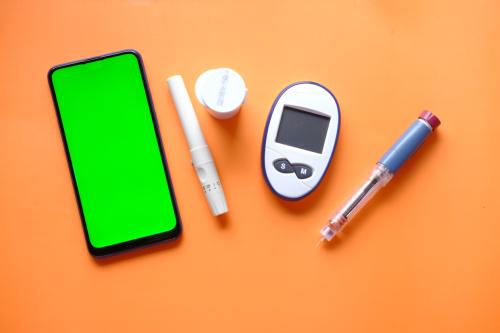 patients more efficient
patients more efficient
People with diabetes are at a higher risk of poor outcomes and severe illness if they develop COVID-19, they need careful glucose monitoring to ensure appropriate glycaemic control during a period of any acute illness, including due to COVID-19.
In order to support the management of these patients at UHCW, digital flash glucose monitoring devices were used as part of a a nationally leading research project. Researchers from WMG at the University of Warwick, and UHCW evaluated the benefits of this trailblazing research.
They found that patients were able to be monitored as effectively as using traditional methods, such as finger pricks and time was saved enabling staff to car for more patients.
Professor Theo Arvanitis from WMG, University of Warwick comments:
“Traditional ways of measuring glucose levels are time consuming and put pressure on resources especially when under pressure from the pandemic, therefore the use of flash glucose monitoring can help free up resources.
“We are pleased to have carried out the first pilot inpatient use of digital flash glucose monitors in an NHS hospital. Overall, there are strong arguments for the inpatient use of these devices in the COVID-19 setting, as we have found that this approach if effective in monitoring patients and can help NHS workers when resources are tight.”
Professor Harpal Randeva from UHCW NHS Trust comments:
“The use of these devices frees nursing time, allows closer monitoring of patients and is popular with them. Building on this evaluation we have now offered devices to over 400 patients with diabetes and COVID-19 and feel this project represents a key step-change in providing care for people with diabetes in hospital. This approach builds on UHCW NHS Trusts Vision of being a National and International leader in healthcare, with a clear focus on world leading digital technology”
Professor Sailesh Sankar from UHCW NHS Trust added:
“Innovation is at the heart of providing the best quality care for people with diabetes. Whilst these devices have been used in the outpatient context, we have achieved the widespread use of devices in an inpatient benefiting both patients and staff. We hope others nationally can learn from this project” The monitor works by measuring glucose from interstitial space, rather than from the blood. They are applied to the patient’s skin and measure glucose levels every 15 minutes for up to 14 days. The glucose levels are then easily read by placing an electronic reader or smartphone over the device, which is more convenient and less invasive than finger-prick monitoring.
Data was gathered from patients who were monitored during their stays, the data was then analysed, and potential associations were explored between relevant parameters, including time in hypoglycaemia, hyperglycaemia, and in range, glycated haemoglobin (HbA1c), average glucose, body mass index (BMI), and length of stay.
Percentage of time in hyperglycaemia exhibited significant associations with both percentage of time in hypoglycaemia and percentage of time in range.
View the academic article hereLink opens in a new window

